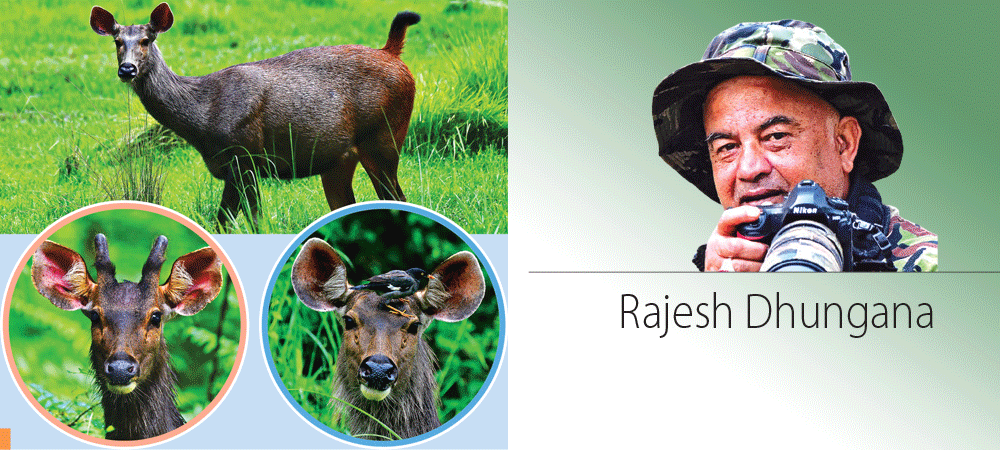- Wednesday, 31 December 2025
National Parks: Home To Sambar Deer
Sambar deer are found in South Asia, including Nepal as well as Myanmar, Thailand, Indochina, Laos, Cambodia, Vietnam, the Malay Peninsula, South China, Taiwan, Indonesia, India, and the Sumatra Islands.
In Nepal, it is found in Bardiya National Park, Banke National Park, Chitwan National Park, Parsa National Park, Shuklaphanta National Park, etc.
Generally, Sambars are 40 inches to 63 inches at their shoulders. It weighs between 100 and 350 kg. The length of the head and body ranges from 5.3 to 8.9 feet. Its tail is 8.7 to 13.8 in length. Individuals belonging to the western subspecies are larger than the eastern ones, and females are smaller than males.
It comes in a variety of shapes and sizes, which caused consternation among ancient scientists, and it has approximately 40 synonyms. Its tail is larger than that of other deer and is usually black outside. And the inside is covered with white. The creatures of the western subspecies are slightly larger than their eastern relatives.
Its horns are big and strong, and they have many branches. Their full adult length can reach 110 cm. Like most deer, antlers are found only
in males.
Hairy Skin
Its hairy skin ranges in colour from beige to dark gray. It is usually solid in color, but some subspecies have reddish-brown markings on the flanks and belly. It also has a short but thick mane, which is more typical in males. Adult males and pregnant or lactating females have a reddish spot halfway down the throat. It is a gland, and sometimes a white liquid comes
out of it.
Large, oblong angles are usually russet; brow tines are simple; and beams are pointed at the tip. So they have three tines. Its horns are usually 43 inches long in fully grown individuals. A male has horns, but a female does not.
Sambar is yellowish brown to dark brown in color. It is usually a uniform color. Some subspecies have chests on the rump and underparts. Sambar is also a short but thick verse. which is more prominent in men. The Sambar deer can be found in tropical temperate forests as well as subtropical rainforests.Sambar Ab is a strong animal. It is an animal found at an altitude of 3500 metres above sea level. According to the dense local environment, the Sambar deer likes different types of vegetation, such as grass, leaves, and green leaves of plants, very much.
Sambar deer are nocturnal or creep scooter. Males live alone most of the year, and females also live in herds of 16. In some areas, it is seen in groups of 3 to 4. Sambar deer are very calm in nature. However, all adults can scream or make small, high-pitched sounds. They usually communicate through scent marking and foot stamping. From the point of view of security, Sambar deer also live in large groups.
They often congregate in watery areas and can swim well. During the breeding season, the male Sambar crows loudly. When they are scared, they also growl at a young age. They can communicate with each other through smell and by stomping on the ground. Male Sambars mix their horns with their urine and rub them
on trees.
Although more than 40 different scientific synonyms are used for its species, seven subspecies of Sambar are recognized. Male Sambar and pregnant or lactating female Sambar have an asymmetrical, hairless, blood-red patch located on the lower half of the bell. It also sometimes releases a white fluid.
Sambar is found in tropical seasonal forests (tropical dry and seasonal moist evergreen), sub-tropical forests (coniferous trees, broad-leaf deciduous trees, and broad-leaf evergreen trees), and tropical rainforests. It does not travel far through water. It is a hardy animal and is found from sea level to an altitude of 3,500 m, such as in eastern Taiwan, Myanmar, and the slopes of the Himalayas.
Sambar prefers the protection of thickets and grasses in deciduous forests, although its range is so wide that a great diversity can be seen in its nature. There is also considerable variation in personal territory, although in India a male's territory is typically 1,500 ha and a female's is 300 ha.
Sambars live in forests and eat a variety of vegetation, such as grass, leaves, plant branches, fruits, water plants, etc., according to the local environment. They also eat many types of shrubs and trees. They are the favourite prey of lions and tigers. Those who live in Sambar's territory, on the other hand, make them their morsels. Leopards and dholes prey on their children or the sick.
Nocturnal
Sambars are nocturnal. They are also very active during dawn and dusk. Males are solitary for most of the year, and females live in groups of up to sixteen. In some areas, only groups of three to four have been observed, under which the mother, her most recently born cub, and the juvenile female, one and a half feet below the tapka, This is a unique behaviour among the animals of the antelope family because they like to live in large groups in terms of security.
Often, they congregate near water sources and are good swimmers. Like other antelopes, the Sambar is also quiet, although the male makes a loud noise during the breeding season. All adults may squeal or emit short growls when frightened. But usually they keep in contact with each other by smelling each other or stomping on the ground. The Sambar male kneads his horns in soil soaked in his own urine and then rubs them along the trunk of the tree.
Genetic analysis suggests that the closest living relative of the Sambar is probably the Javan Rus from Indonesia. This is supported by reports that Sambars can still interbreed with this species to produce fertile hybrids.
Fossil Sambars are known from the early Pleistocene, although they are very similar in form to early deer species from the Pliocene and are not identical to more modern cervids. The species probably originated in the tropical regions of southern Asia and later spread throughout its present range. Epirusa and Eucladoceros have both been proposed as possible ancestors of the living species and its closest relatives.
Breeding
Sambar deer breed together throughout the year. Oestrus lasts about 18 days. Male Sambar establishes a territory. From there, he attracts nearby females, but he does not form a harem. The male hits the ground and creates a hollow patch. Pregnancy probably lasts about 8 months. However, some studies suggest that this may be much longer. Usually only one calf is born at a time. Initially weighing 5 to 8 kg, the calves do not have spots. Although some subspecies have some light spots, the spots disappear on their own after a long time. The Sambars lived for 28 years
in Sardaram.
However, they rarely live more than 12 years in the wild. In 2008, the IUCN listed the Sambar deer as a vulnerable species. According to Nepal's National Parks and Wildlife Protection Act 2029, hunting or injuring a Sambar can be punished with a fine of 40,000 to 75,000 rupees or imprisonment for 1 to 10 years, or both.
(Dhungana is a senior wildlife photographer and writer.)
















